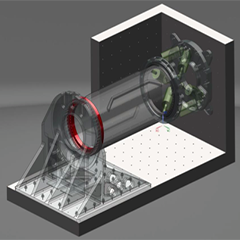Blade bearings might not exactly be the most expensive components in a wind turbine, but damage to this fundamental part of the system can result in considerable downtimes and costs. By designing and testing blade bearings under realistic conditions reliable operation of future turbines shall be impro- ved. In the HAPT research project (short for Highly Accelerated Pitch Bearing Test) researchers from the Fraunhofer Institute for Wind Energy and Energy System Technology IWES Nordwest and the Institute of Machine Elements, Engineering Design and Tribology (IMKT) at Leibniz Universität Hannover (Uni- versity of Hanover) work together with the IMO group to establish the foun- dations for the further development of blade bearings. It is also aimed that the project results will allow the use of individual pitch control systems for load reduction – a primary goal of the manufacturers. The German Federal Ministry for Economic Affairs and Energy (BMWi) provided funding for the project to the tune of € 10.7 million.
In wind turbines in the 7-10 MW range, the wind drives blades of up to 80 m in length. Blade bearings, the interface between the hub and the blades, are the design bottle- neck in the development of systems of this size. Due to the sheer dimensions of the blades, the systems are subject to effects which can be already detected in turbines with smaller dimensions but are not all that significant. As the load increases, faults in the blade bearings also increase exponentially and the rate of damage rises. At the same time, almost no information is available on how and why these faults develop. As a result, experience-based design of blade bearings, standard practice among manufac- turers, is now reaching its limits.
One possibility for reducing the loads to which the structure of the wind turbines is subject is individual pitch control (IPC), which balances out the loads across the individ- ual blades and reduces them overall. However, as there is still no reliable information available concerning the suitability of blade bearings for the use of IPC and because the latter further increases the demands placed on the blade bearings, the industry sector remains somewhat hesitant to introduce this seminal technology.


























